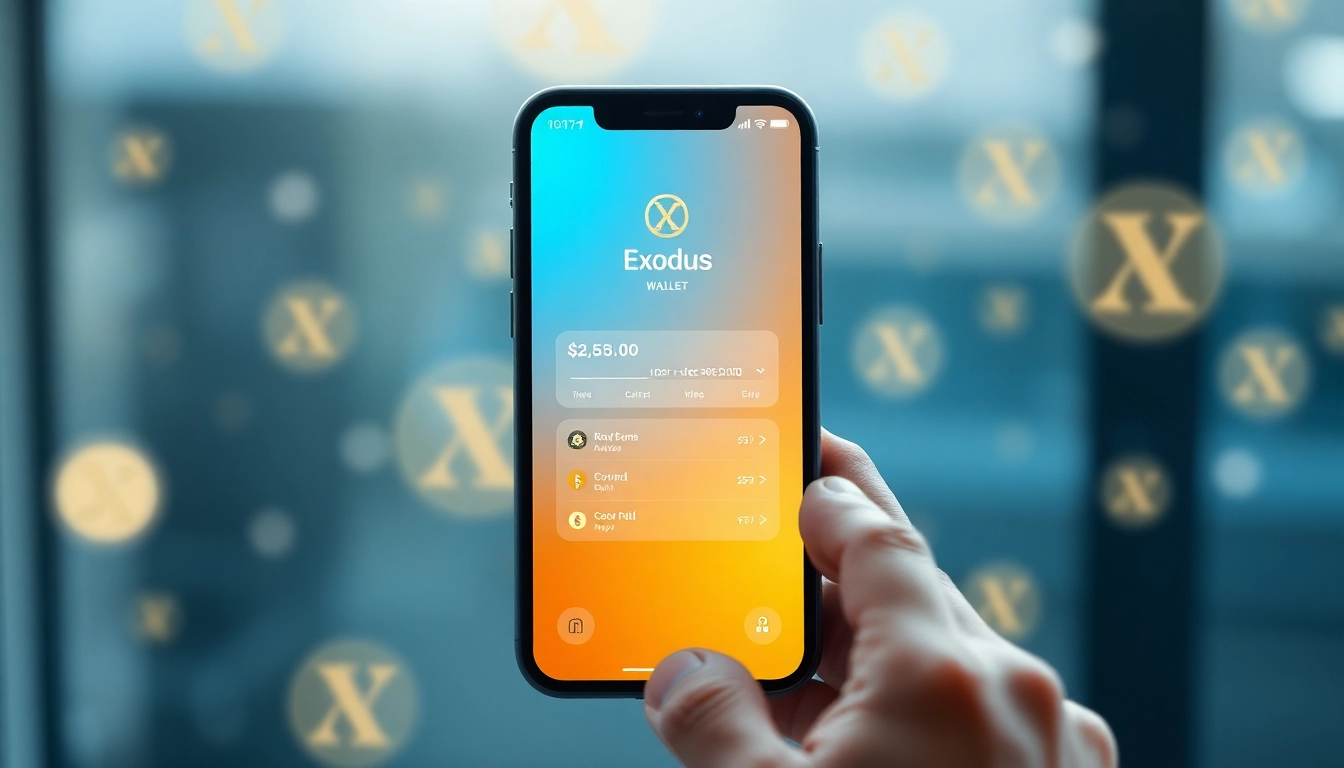Understanding Exodus Wallet
What is Exodus Wallet?
Exodus Wallet is a popular multi-currency software wallet designed for cryptocurrency enthusiasts, offering users a seamless way to manage their digital assets. Launched in 2015, Exodus is known for its user-friendly interface and supports over 100 cryptocurrencies and tokens. Unlike many wallets, Exodus operates as a non-custodial wallet, meaning users have sole control of their private keys and, consequently, their assets. This high level of control ensures secure transactions without the need for a centralized authority.
Exodus Wallet enables users to send, receive, and exchange cryptocurrencies directly within the platform, creating a holistic ecosystem for managing digital currencies. Its design emphasizes accessibility, making it an ideal choice for both beginners and seasoned crypto traders.
Key Features of Exodus Wallet
- User-Friendly Interface: Exodus Wallet features a sleek, intuitive design that makes cryptocurrency management straightforward, even for those new to the space.
- Multi-Currency Support: With support for over 100 cryptocurrencies, including Bitcoin, Ethereum, and many altcoins, users have the flexibility to manage a diverse portfolio.
- Integrated Exchange Functionality: Users can quickly swap cryptocurrencies with a few clicks, leveraging built-in exchange features that connect to multiple liquidity providers.
- Wallet Backup and Recovery: Exodus provides users with tools like seed phrases to easily backup and restore their wallets, ensuring their assets are safe in case of device loss.
- Cross-Platform Compatibility: The wallet is available for desktop (Windows, macOS, and Linux) and mobile (iOS and Android), allowing users to manage their assets on the go.
- Secure Private Keys: Being a non-custodial wallet, Exodus holds no user data, and all private keys remain stored on the user’s device, enhancing privacy and security.
How to Get Started with Exodus Wallet
Getting started with the exodus wallet is straightforward and involves a few simple steps:
- Visit the Exodus website or download the wallet app from your app store.
- Install the application on your device and launch it.
- Follow the on-screen instructions to create a new wallet. You will be prompted to set a secure password.
- Make sure to back up your recovery phrase. This phrase is crucial for accessing your wallet if you forget your password or lose your device.
- Start adding assets to your wallet by transferring cryptocurrencies from other wallets or exchanges.
Setting Up Your Exodus Wallet
Installation and Download Options
To download the Exodus Wallet, users can visit the official website or their respective app stores. The wallet is available for multiple platforms, ensuring ease of access:
- Desktop: Available for Windows, macOS, and Linux.
- Mobile: Users can download the app on both iOS and Android devices via their app stores.
The installation process is straightforward. After downloading, users must follow installation prompts, which typically involve agreeing to terms and conditions and choosing an installation path if using a desktop version.
Creating Your Wallet: Step-by-Step Guide
Once installed, creating your wallet involves these essential steps:
- Open the Exodus app after installation.
- Select the option to create a new wallet. You will be prompted to create a password that must be unique and secure.
- After setting your password, you will receive a 12-word recovery phrase. Write this down and store it securely—this is your only chance to recover your wallet.
- Confirm your recovery phrase as prompted by re-entering the words in the correct order.
- Your wallet is now set up, and you can start adding funds!
Backup and Security Settings
Exodus provides robust backup options to secure your wallet. Users should take the following actions:
- Store Your Recovery Phrase Safely: Write down your recovery phrase on paper and keep it in a secure location away from your devices.
- Regular Wallet Backups: Regularly backup your wallet data within the app settings to safeguard your assets against loss or theft.
- Enable Password Protection: Always use a strong password to access your wallet, as it adds an extra layer of security.
Using Exodus Wallet for Transactions
How to Buy and Exchange Cryptocurrencies
Exodus allows users to buy cryptocurrencies directly from the wallet using third-party services. Here’s how to do it:
- Select the option to buy cryptocurrencies from the home screen.
- Choose your desired cryptocurrency and enter the amount you wish to purchase.
- Select your payment method, typically credit/debit cards or bank transfers, and complete the transaction.
Advanced Features: Swapping and Trading
Beyond buying and selling, Exodus Wallet offers advanced features for swapping and trading:
- Instant Swaps: Users can easily swap between different cryptocurrencies without leaving the app. This is executed through integrated exchanges, making the process seamless.
- Trade Execution: Trades occur in real-time and are powered by multiple liquidity providers, ensuring users receive competitive rates.
- Portfolio Management: Exodus provides a portfolio tab where users can track their asset performance over time.
Fees Involved and Cost Optimization
While Exodus charges for swaps and trades, understanding the fee structure can help users optimize costs. Fees can vary based on:
- Network Congestion: Transactions may become more expensive during periods of high network activity.
- Transaction Speed: Users can often select the level of transaction speed, influencing the fee amount.
To minimize costs, users can monitor the network conditions before executing trades and choose times when fees are lower.
Security Insights for Exodus Wallet
Is Exodus Wallet Safe? Key Considerations
Exodus Wallet is recognized for implementing several security measures to protect users’ cryptocurrencies:
- Non-Custodial Nature: As a non-custodial wallet, users have complete control over their keys, reducing the risk of hacks associated with centralized exchanges.
- Regular Software Updates: Exodus frequently updates its software to address vulnerabilities and enhance security features, ensuring users are protected against potential threats.
- Biometric Security: For mobile users, enabling biometric login (Face ID or fingerprint recognition) provides additional access security.
Best Practices for Keeping Your Wallet Secure
To maintain the security of your Exodus Wallet, consider the following best practices:
- Enable Two-Factor Authentication: Whenever possible, include 2FA for additional security on any connected accounts.
- Avoid Phishing Scams: Always download updates from the official website or trusted app stores, and avoid clicking suspicious links that may lead to phishing sites.
- Use a Strong Password: Employ a complex password that incorporates letters, numbers, and symbols to enhance security further.
Cold Storage vs. Hot Storage: What to Know
Understanding the difference between cold storage and hot storage is crucial for managing cryptocurrency securely:
- Hot Storage: Refers to wallets that are connected to the internet (like Exodus), offering convenience for transactions but with increased risks of hacking.
- Cold Storage: Involves storing cryptocurrencies offline (e.g., hardware wallets), providing a higher security level against online attacks.
For long-term holdings, many users opt for cold storage solutions, while hot wallets like Exodus are useful for active trading and immediate access.
Frequently Asked Questions about Exodus Wallet
Common Issues and Troubleshooting
Users may encounter specific challenges when using the Exodus Wallet. Here are some common issues and solutions:
- Transaction Delays: If a transaction is taking longer than expected, check the network congestion on the respective blockchain. This can often lead to delays.
- Recovery Phrase Issues: If users cannot recover their wallet due to a lost or faulty recovery phrase, unfortunately, there’s no way to access funds, emphasizing the importance of securely backing it up.
User Experiences: Exodus Wallet Revealed
User reviews indicate that many people appreciate the wallet’s simplicity and the breadth of supported currencies. Common praises include its interface, customer support responsiveness, and easy backup processes. However, concerns often arise regarding fees associated with swaps and the fact that the wallet is software-based, which poses risks compared to hardware wallets.
Future of Exodus Wallet and Its Features
Exodus is constantly evolving, with anticipated future features that could further enhance user experience:
- Enhanced Privacy Features: As concerns grow around privacy, future updates may focus on incorporating additional user anonymity options.
- DeFi Integration: More integrations with decentralized finance (DeFi) platforms could enhance usability for users looking to earn passive income.
- Expanded Customer Support: Ongoing improvements in customer service can play a pivotal role in user satisfaction and improved wallet functionality.

